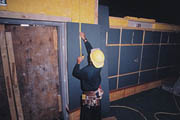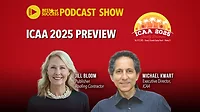ICAA’s Commercial Insulation Agenda
Providing the industry with uniform specifications for commercial projects, certifying insulation contractors and taking advantage of opportunities in the retrofit market were a few of the important matters taken up at the recent meeting of the Insulation Contractors Association of America’s (ICAA) commercial committee.

Master Spec Review
The lack of a good set of master specifications for commercial insulation products has been no small issue for the industry. There are some available, but since they are rather awkward to deal with, the committee decided to put together a specification that would include the different types of insulating products in typical projects — not an easy task. Unlike residential projects, which are comparatively uniform, the commercial sector is full of exceptions.The association commissioned a spec writer to draft the original formal-type specification, and the commercial committee has been soliciting comments on CSI specification 07210 for building and acoustical insulation. A final draft for review will be prepared for the committee’s next meeting this coming June. Assuming that process goes well, the final document could be produced and available in time for the association’s annual convention and trade show (Oct. 18-20 in St. Louis).
Insulation contractors will be able to go to one place and find the specifications they need for commercial insulation projects — most of them, anyway. With all the exceptions that the commercial industry presents, it would be impossible to cover every single situation, but the new document should cover 95 percent of the applications.
The specification will be sent to CSI where it can be endorsed and referred to, giving it de-facto industry standard status.
Tom Newton (CertainTeed Corp.) is the point person for receiving input on this important project. If you have anything to contribute, you can reach him at 610.341.7739.
Contractor Certification
McKenzie Insulation Co., Acworth, Ga., has been awarded commercial insulation contractor certification by the ICAA’s commercial committee. McKenzie now is included in ICAA’s database that building owners/developers go to when looking for a qualified contractor.Because there are so many different types of commercial buildings, it often is difficult for a general contractor or building owner to know which insulation contractors should be invited to bid on a given project.
Certified contractors must demonstrate to the association that their companies are financially stable, that they are bonded and that they have proper insurance. Then they fill out an extensive questionnaire, listing all the different types of commercial projects they’ve completed. Potential clients can go to the ICAA’s Website and see which contractors have experience in the type of installation they require. As contractors gain experience in new markets or installations, they can update the database accordingly.
The commercial insulation contractor certification is a very helpful program in a notably complex market.
Retrofit Market
The commercial retrofit market represents a solid opportunity for insulation contractors. Buildings that just a few years back would likely be demolished are now being rehabbed and retrofitted. Signs point to continued steady growth in this market segment for the foreseeable future.Interesting development: Demand-side management programs that have been helpful on the residential side have sprung up in the commercial market. Utilities and energy service companies (called ESCOs) have plans in place in which they go to a building owner and say, “We can improve the energy efficiency of your building complex.” Say the job would cost $3 million. The advantage of retrofitting commercial buildings over residences is that the commercial jobs can pay for themselves in very short order. The utility or ESCO says, “We’ll do this on a fee basis. We’ll supply the capital for the project.” The building owner reimburses them out of the energy savings. For example, if the energy bill was $50,000 and after the retrofit it was $38,000, that’s a $12,000 savings that gets split between the customer and the utility or ESCO until a maximum payout has been reached. This arrangement allows a customer that wouldn’t otherwise have the cash do the retrofit at one time to do so. This is something that the ICAA is working with the ESCO association on so that contractors can capitalize on these arrangements. There is strong optimism that this could be a big opportunity down the road.
Looking for a reprint of this article?
From high-res PDFs to custom plaques, order your copy today!



